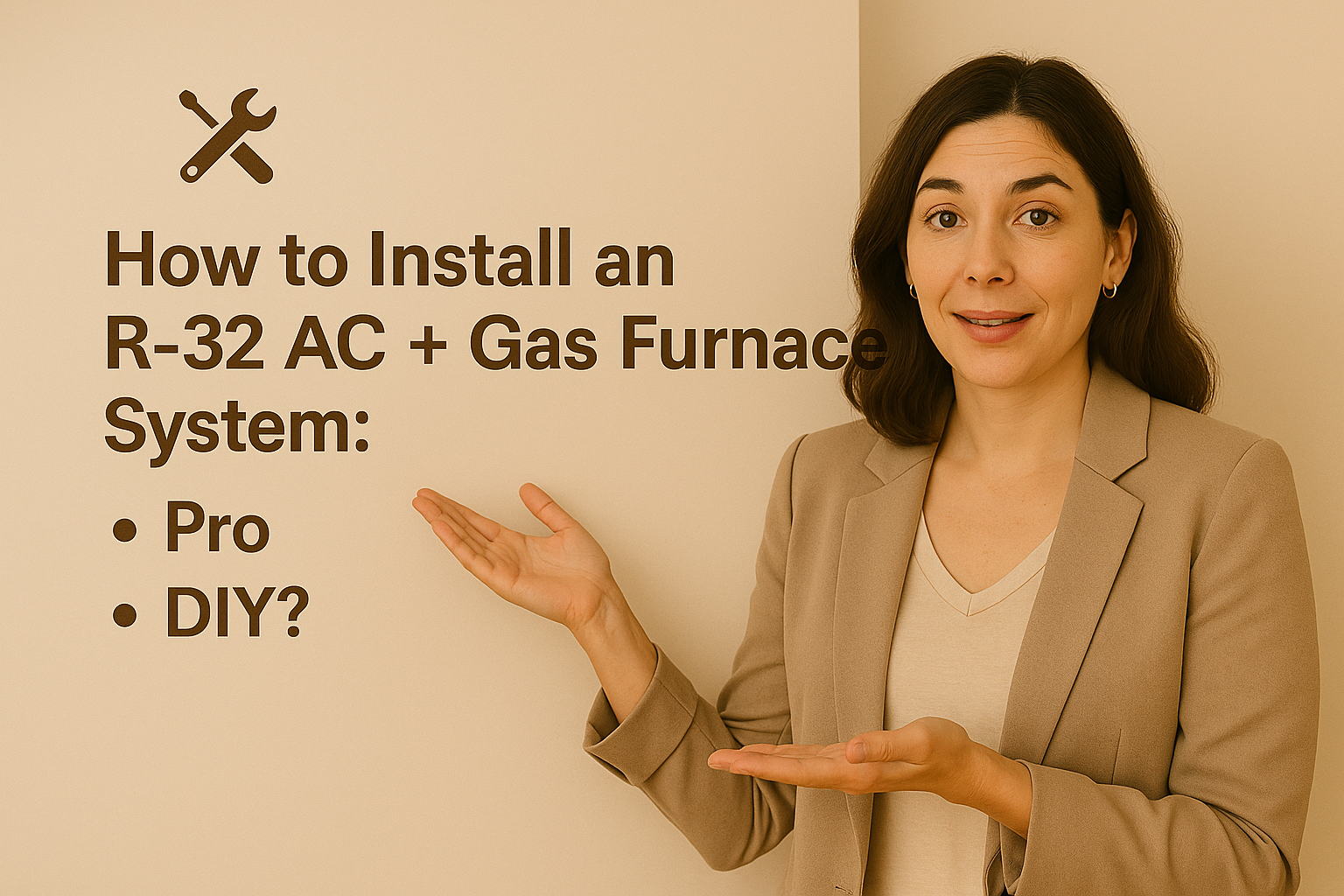Installing a new HVAC system is one of the most impactful upgrades you can make for your home—but when it comes to installing a dual fuel R-32 AC and gas furnace system, should you call a pro or tackle it yourself?
This comprehensive guide will walk you through everything you need to know about the installation process, permits, costs, and DIY challenges—so you can make a savvy decision for your home.
🧊 What Makes R-32 Systems Different?
Before we dive into installation, let’s quickly recap what sets R-32 systems apart:
-
✅ Eco-Friendly: Global Warming Potential (GWP) of 675 (vs. 2088 for R-410A)
-
✅ High Efficiency: Requires up to 30% less refrigerant charge
-
✅ Mildly Flammable (A2L): Requires specific handling and tools
📘 For details on R-32 handling, see ASHRAE's R-32 Classification Guidelines.
🔍 What’s Included in an R-32 AC + Gas Furnace Package?
A typical dual-fuel system from The Furnace Outlet may include:
-
R-32 Air Conditioner or Heat Pump
-
High-Efficiency Gas Furnace (natural gas or propane)
-
Indoor Coil or Air Handler
-
Refrigerant Line Set
-
Thermostat (often smart-capable)
-
Install Kit (optional)
These components must be correctly sized, matched, and installed per manufacturer and code requirements.
🛠️ DIY HVAC Installation: Is It Legal?
The short answer? It depends, but in most U.S. states and municipalities:
❌ Homeowners cannot legally install HVAC systems that:
-
Involve refrigerant charging
-
Require gas line connections
-
Require electrical work beyond plug-in
-
Don’t follow code or permitting processes
❗ EPA Section 608 certification is required to handle refrigerants like R-32.
Learn more directly from the EPA’s Refrigerant Handling Certification Guide.
That said, handy homeowners can assist in some portions of the project—like site prep, electrical disconnects, or thermostat installation—but the core system must be installed and charged by a licensed HVAC professional.
💡 R-32: Special Considerations for Installers
R-32 is classified as A2L (mildly flammable), and while it is safe when properly installed, the refrigerant requires:
-
Leak-proof brazing or flare fittings
-
Ventilation awareness during charging
-
Special R-32-compatible gauges and vacuum pumps
-
Charging per manufacturer specs (by weight, not pressure)
👷 When You Should Hire a Pro
Savvy’s rule of thumb? If refrigerant or gas is involved, call a licensed contractor.
Hire a pro if:
-
You’re installing a split system
-
You need to connect a gas furnace
-
You’re dealing with line set brazing or flare fittings
-
You want to protect your warranty
-
You’re unsure how to obtain permits and inspections
Many manufacturers—including those carried by The Furnace Outlet—void warranties if unlicensed individuals perform the install.
📜 Need help finding a licensed pro? Use Angi’s HVAC Directory to find certified installers near you.
💸 Installation Costs Breakdown
HVAC install costs vary by region, but here’s what you might expect:
| Task | Cost Estimate |
|---|---|
| AC/Furnace Installation (Labor) | $2,500 – $4,500 |
| Ductwork Repair/Retrofit | $500 – $2,000 |
| Thermostat Install (Smart) | $100 – $300 |
| Permit/Inspection Fees | $100 – $500 |
| R-32 Refrigerant Charging | $150 – $400 |
🧮 Total range for full professional install: $3,500 – $7,500, depending on home size, region, and scope of work.
🧰 Can You Do Any of It Yourself?
While full DIY is out of bounds for most people, you can still assist with prep tasks to cut down on time and cost:
✅ Homeowner-Friendly Tasks:
-
Thermostat wiring and programming
-
Electrical disconnect installation (if pre-wired)
-
Pad or platform setup for the outdoor unit
-
Duct sealing and insulation
-
Air filter and return grille installation
These can save your contractor time—and save you some cash.
📋 Permits and Inspections
Don’t skip this step.
Installing a furnace or AC without the proper permits can:
-
Void your home insurance
-
Cause issues when selling your home
-
Lead to fines or rework orders from inspectors
Permits are usually required for:
-
Gas line connections
-
Electrical modifications
-
Refrigerant line connections
🧾 Warranty Protection
Almost all HVAC manufacturers require:
-
Licensed installation
-
Proof of permit
-
Registration within 60–90 days
That means your R-32 system may not be covered if:
-
You do the work yourself
-
You skip permitting
-
You don’t register the product in time
💡 Want help? The Furnace Outlet can guide you through registration and installer verification—just ask.
🔌 Smart Thermostat Setup: A DIY Opportunity
One task most homeowners can do confidently is install and configure a smart thermostat.
Recommended models:
-
Honeywell T10 or VisionPro 8000
-
Google Nest (with dual fuel relay kit)
Be sure your new thermostat supports:
-
Dual fuel switching (if applicable)
-
R-32-compatible systems
-
Two-stage cooling/heating (if your system has it)
For help, follow ENERGY STAR’s Smart Thermostat Setup Guide.
🧠 What Savvy Thinks
“Trying to install your own R-32 system is like replacing your car engine in your garage—it’s doable in theory, but risky, technical, and not worth the warranty gamble.”
— Savvy
Instead, focus on prep, coordination, and education. A knowledgeable homeowner working with a pro always gets the best results.
🛒 What to Do Next
-
📐 Confirm the size of your system with our HVAC Sizing Guide
-
🔍 Review R-32 install considerations
-
📞 Contact a licensed installer near you
-
🛒 Choose your matched AC + gas furnace system:
In the next topic you will read about: Tax Credits and Rebates for High-Efficiency HVAC Systems (2025 Edition)







